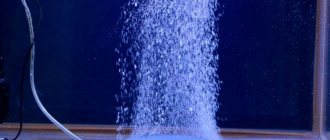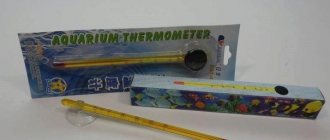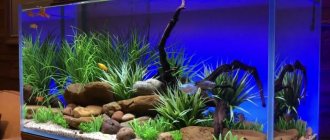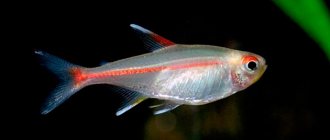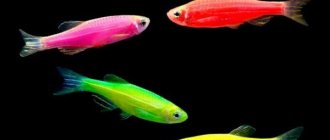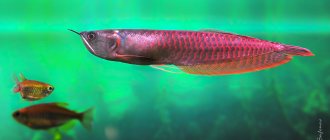Forming an environment close to natural in an aquarium requires compliance with certain conditions. These include maintaining the temperature of the water and saturating it with oxygen. It is also important to create the necessary lighting. Modern aquarium lamps will help with this. Aquarium lamps perform a lighting function and have a beneficial effect on the development of plants and the life of aquatic fauna.
In a home aquarium, it is very important to create the necessary lighting. For this, special aquarium lamps are used.
What to look for when choosing
Colorful temperature
Color is determined on the Kelvin scale. Cool colors go 5000K, warm colors go higher. The shade does not particularly affect the growth and development of plants and fish. It is worth choosing the option that best conveys the beauty of the content. Lamps from 6500 K and above are suitable for plants.
Length
When choosing, it is important to consider the size of the lamp. It should be the same length as the aquarium itself. Otherwise, the light will not capture the side parts, which will negatively affect the quality of lighting.
Power
The lamp must provide the proper level of illumination taking into account the power of the luminous flux. For light-loving plants, lamps of 0.8-1 W per 1 liter of water are intended. For algae that do not require a lot of light, spotlights with a power of 0.5 W per 1 liter of water are suitable.
Important! When selecting a lamp, conditions regarding intensity, spectrum of light and duration of illumination are taken into account.
Other types of devices
Another optimal option for lighting is LED bulbs. They emit light close to natural. Using LED devices, a constant water temperature is maintained. They have a longer service life compared to others.
There are other types:
It is recommended to use a combination of fluorescent and metal halide lamps. The latter need to be turned on for a few hours, the rest of the time the fluorescent ones work. At night the lighting is completely turned off. Thus, the daylight hours are recreated. Its duration should not exceed ten hours.
Lighting is measured in more than just watts. There is also a light spectrum - the range of colors perceived by the human eye.
Frequently asked questions from users
How to choose the right lamps for an aquarium?
If there are no plants in the aquarium, then you can play with the spectrum. And so select 0.5 W per 1 liter. In general, a 30 W lamp is enough for a 100-liter aquarium.
An aquarium lamp is a necessary lighting device for improving photosynthesis of plants and for emphasizing the color of fish and grass. The review included the best fluorescent, LED, and metal halide models. When choosing, you should pay attention to the luminous flux, glow temperature, power and length of the lamp.
AQUAkmv
Post Views: 2,206
In this article I would like to talk about the choice of fluorescent lamps (FL) for lighting an aquarium with live plants.
To begin with, let’s define how LLs differ and what they are.
At the moment, it is customary to use 2 main types of LL in the aquarium hobby. These are T5 lamps and T8 lamps, they are easy to find for sale even in ordinary hardware stores, it is easy to select electronic ballasts (electronic ballast) for them, and finally, they are cheap and have all the necessary parameters for installation in an aquarium. T4 lamps, lamps of Asian standards (for example in JUWEL aquariums), and compact fluorescent lamps (CFL) can also be used.
Let's start with T8. They have been used in aquarium keeping for a very long time, back in 1999, when I started getting involved in aquarium keeping, we installed such lamps. Then they were called “fluorescent lamps” (who remembers LB, LD, LBT lamps, etc.). To start such lamps, chokes were used in conjunction with starters. Such lamps were heavy, starters often failed, chokes hummed, and interfered with a nearby radio receiver... But it was still much better than incandescent lamps. Such a lamp was very cool and technologically advanced in those days.
| Throttle | Starter |
But, fortunately, progress does not stand still! And electronic ballasts - Electronic ballasts - come to our aid.
This is a regular Feron:
More expensive, with self-clamping terminal blocks and high-quality filling:
A very convenient thing. In order to assemble a lamp on it, you need the electronic ballast itself and the lamp, and that’s it, no starters, chokes, or filter capacitors. Plus it has a much higher efficiency, and therefore the light output of the lamp. It does not create interference in networks, lamps with it last much longer (this statement does not apply to Chinese electronic ballasts for 100 wooden ones).
A typical connection diagram looks like this:
or like this:
In a modern aquarium, this is exactly the scheme that is used, only the number of lamps can be different, one or ten.
As I already mentioned, previously all we could afford were LB and LD lamps, and a couple of other types. And now everything is much more complicated and interesting.
In order not to get confused in this variety, you just need to look at the inscriptions on the lamp.
With LL, the power and length of the lamp are always strictly dependent.
For T8 lamps (G13 base, distance between legs 13 mm) everything is simple:
| 15 W | 450mm |
| 18 W | 600mm |
| 30 W | 900mm |
| 36 W | 1200mm |
| 40 W | 1200mm |
| 58 W | 1500mm |
| 80 W | 1500mm |
With T5 lamps everything is a little more complicated. In general, you should know that they come in two types: HE and HO.
T5 HO - high luminous efficiency - optimized for maximum light output T5 HE - high efficiency - lamps with reduced energy consumption
Naturally, for our needs we only need HO lamps.
Here's how things work with their sizes:
| 24 W | 550mm |
| 39 W | 850mm |
| 54 W | 1150mm |
| 80 W | 1450mm |
Well, and finally, I would like to add about non-standard lamps (JUWEL, etc.). They were created to replace old T8 lamps with T5 lamps without altering the luminaire.
| Power T8 | Length | Power T5 |
| 15 W | 440mm | 24 W |
| 18 W | 600mm | 28 W |
| 25 W | 740mm | 35 W |
| 30 W | 900mm | 45 W |
| 38 W | 1050mm | 54 W |
| 36 W | 1200mm | 54 W |
Now let's talk about color rendering and color temperature of lamps.
The spectrum and phosphor of LL are very well written HERE. Without going into details, I will say:
The visible spectrum looks like this:
And this is how light is divided by color temperature:
Any modern imported LL has an inscription like L18W/830, the last 3 digits are what we need.
The first number is the color rendering index of 1x10 Ra. The higher the index, the better the color rendition. The second two digits are the color temperature of 100K.
Thus, the designation 830 means that this is a lamp with a color rendering of 80 Ra and a color temperature of 3000K.
The most common markings are listed below: 530 – Warm-colored light with poor light transmission; 640, 740 – Cool light with mediocre color rendering and light output; 765 – Bluish “daylight” light with mediocre color rendering and light output; 827 – Similar to incandescent light with good color rendering and light output; 830 – Similar to the light of a halogen lamp with good color rendering and light output; 840 – White light for work surfaces with very good color rendering and luminous efficiency; 865 – “Day” light with good color rendering and mediocre light output; 880 – “Daylight” light with good color rendering; 930 – “Warm” light with excellent color rendering and poor light output; 940 – “Cold” light with excellent color rendering and mediocre light output; 954, 965 – “Daylight” light with a continuous spectrum of color rendering and mediocre light output. Used to illuminate exhibition halls and aquariums.
Well, what to choose for a beautiful herbalist?
There is a lot of controversy among aquarists here. Everyone has their own truth.
But the most common combinations of household lamps are 830, 840, 865, 880 and 965.
Manufacturers preferably take Philips or Osram.
Among specialized lamps for aquariums, Sylvania lamps have proven themselves to be excellent. This is Sylvania AquaStar, Sylvania Grolux.
Personally, I tried several combinations, but settled on these.
For my 110L I chose 5 LL lamps and 2 CFL lamps in this composition:
5 LL = 3 x 880 + 2 x Sylvania Grolux + 2 CFL 4200K or so
5 LL = 2 x 865 + 2 x Sylvania Grolux + 1 x 830 + 2 CFL 6400K.
Aquarium lighting - why is it needed?
People who are far from the aquarium culture may believe that herbalists need to be illuminated only for a decorative effect.
Experienced aquarists know that in order for whimsical tropical plants to please the eye, it is not enough to illuminate them - they need to be illuminated correctly. And, in addition, provide sufficient “food” - carbon dioxide and fertilizers. Why are we so concerned about the lighting problem? Yes, because we know from the school biology curriculum that without it (without light) the process of photosynthesis, or, in simple terms, plant nutrition, is simply impossible. This means that the plants will neither grow nor develop.
This does not mean that if you illuminate an aquarium with plants around the clock, they will begin to “rage” in all their glory. Their natural conditions suggest a change of day and night, and in the tropics they are approximately equal. This means that a period of rest is obligatory for plants, as it is for humans. And it should last at least 12 hours.
Excessive illumination, as well as its lack, can provoke the appearance of algae, stretching of plants or freezing of growth points. To conveniently control the lighting time, you can use special electronic or mechanical timers.
How to make it yourself
If the lighting fails, you don’t have to order a new one; you can make an LED lamp for a marine aquarium with your own hands. For this we need:
- Cover from an old lamp;
- AQ diodes 3–5 Watt. – 6 pcs;
- UVR UV, 1 watt, 3 pcs;
- 3GR-B blue, spectrum - 445–452 Nm, 4 pcs;
- 3HPD 3 W, 5 pcs;
- Drivers: IPS 60 400-700, HG-PC2206-320ma;
- Converter 220/12v 300mA.
Sequencing:
- We take out the non-functioning elements from the radiator.
- We place the location of the new ones and install the diodes with glue.
- We measure the size of the radiator and cap, they must match.
- We connect the radiator and the cover with bolts.
- We solder the diodes into three series circuits. The first is for 2 diodes from a converter with a current of 300 mA, to the switch button from the lamp cover. The second is 3 UV diodes for a current of 320 mA from the driver. Next: 4 pcs. diode AQ plus 4 pcs. 3GR-B, plus 5 pcs. 3HPD.
- We connect the last two chains to the second switch on the lid.
- Install the driver.
- We fasten the protective glass with bolts.
Before installing it on the aquarium, we check the operation of the lamp.
We recommend watching the video:
Backlight location
According to many experienced aquarists, the best lighting effect is created by installing a light source from above. You can attach the lamp directly to the lid of the aquarium, or position the unit at the front or side of the tank.
The light source must uniformly illuminate the water space, including covering the bottom area. If the lower part of the aquarium remains in the shade, it is necessary to replace the lamp with a more powerful one. This problem can also be solved by equipping the aquarium with additional lights, placing them on the upper side walls.

